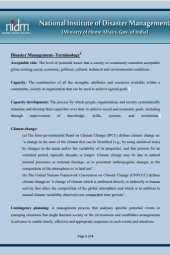Disaster Management Terminologies
Summary
The document "Disaster Management Terminologies" published by the National Institute of Disaster Management, Ministry of Home Affairs, Government of India, serves as a comprehensive reference for key concepts in disaster management. It provides clear definitions and explanations of terminologies essential for understanding and implementing effective disaster response strategies. The terminologies cover various aspects, including risk reduction, preparedness, response, recovery, and resilience. Aimed at practitioners, policymakers, and the public, the document contributes to a common understanding of disaster management language, fostering improved communication and coordination in the field. It is a valuable resource for those involved in disaster management efforts in India.
Categories:
Legal Document
Publisher:
Government of India
Published Year:
2014
